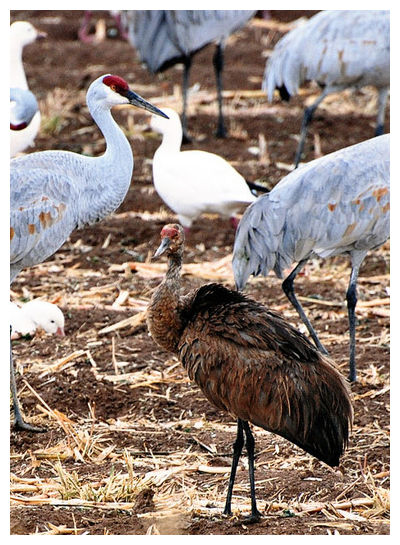
Albuquerque, N.M. - Wildlife managers at one of the nation's premiere bird-watching spots have a mystery on their hands. A strange-looking bird with dark plumage showed up at the Bosque del Apache National Wildlife Refuge earlier this month to join the tens of thousands of cranes and geese that spend the winter in the Rio Grande Valley.
The problem: No one knows exactly what kind of bird it is.
The debate has spread from the refuge's fields and wetlands onto Facebook, where guesses have ranged from some kind of mutant to a Thanksgiving turkey disguised as a crane for self-preservation. Birding experts from New York to California continued studying photographs of the bird Thursday, spurring even more theories.
The refuge posted a photograph of the bird on its Facebook page this week, sparking dozens of comments. Aside from the disguised turkey and oil-slicked bird theories, some suggested it could be a hybridization between a crane and an emu or a trumpeter, which are native to South America.
It could be a sandhill crane that has come down with a feather-staining fungal infection. Or maybe he - or she - has a genetic disorder that results in too much melanin production.
"It's different. It's got to be a hybrid-cross more than likely, but what, we don't know," Refuge Manager Aaron Mize told The Associated Press in a phone interview.
Members of the Cornell Lab of Ornithology's Team Sapsucker - known as some of the best birders anywhere, they hold the U.S. record for finding the most bird species in 24 hours - say it's a sandhill crane. "We can't say why it's colored so differently, but we can be certain about species anyway," said Pat Leonard, a spokesman for the Cornell lab.
Other bird-watchers have reported seeing birds with similar coloring in wintering areas in California and along the Platte River in Nebraska. Some experts have said breeding birds have been known to preen mud into their feathers, resulting in the unusual colors.
The refuge said Thursday a closer look at the bird through a spotting scope called into question at least one theory - that it had a case of feather-munching mites.
The only way to determine with certainty is to capture it so blood, tissue and feather samples can be taken and DNA tests runs. But managers at Bosque del Apache say it's not worth stressing out the bird for the sake of answering what amount to a trivia question.
"Whatever it is, it's doing what a bird does. It looks healthy and happy so we'll leave it alone," Mize said. "We probably won't ever know but it's fun to speculate. It gets people excited. It's interesting. It's a curiosity and that's how we'll treat it."
The bird showed up about a week before the refuge's annual crane festival, which draws thousands of bird-watchers from across the country. It stood out against the sea of gray sandhill cranes and white snow geese.
The bird is both shorter and skinnier than a lesser sandhill crane. The muscle structure of its legs appears to be different and so does its body shape, but Mize said its bill is crane-like.
When cranes fold their wings, their feathers drape over their rear ends in that classic crane-like flow. Not so much with this mystery bird. "He's goofy looking," Mize said.
The cranes that spend the winter at Bosque del Apache come from as far away as the western coastline of Alaska. Mize said that doesn't mean some rare bird can't hop a thermal and find its way to the refuge. "Birds from all over the world can - and they do - show up in weird places because it's the nature of birds. They can fly," Mize said. "This one is just a little different."



My best guess: An Immature Hybrid/cross of a Whooping Crane and a Sand Hill Crane?
Whooping cranes are white with black while Sand Hills are Grey. Both have similar red patches on faces/beaks.
I've seen one Whooping Crane in my life of birding.
R.C.